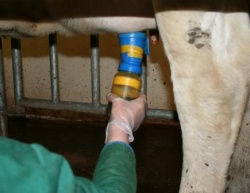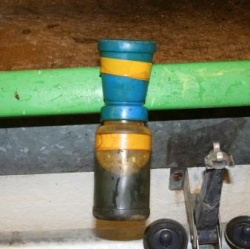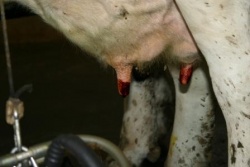Post-Milking Teat Disinfection
Also known as: PMTD
Introduction
After milking, it is common practice to disinfect the cow’s teats. This is because when a cow with subclinical mastitis has been milked in the parlour, viable pathogens may be left in the teat liner which can infect subsequent cows milked. With subclinical Staphylococcus aureus infection, it is believed that infection can spread to the following 6-8 cows milked with the same unit. Disinfection of the teat skin after milking will help reduce the chance of the spread of contagious mastitis pathogens by stopping them entering and colonising the mammary gland. This process can be combined with disinfection of the cluster unit.
Post milking teat disinfection is a component of the five point plan. It is advised that all herds perform this practice on all lactating cows, all year round.
Objectives
There are two main objectives to post milking teat disinfection:-
- To kill any bacteria present that have been transferred from the teat liners left by previous cow
- To improve/maintain good teat condition
Products
Various products exist for post milking teat disinfection. The desired properties are to have a persistent and effective killing action but also to leave the teats in a good condition. A balance must be stuck between these two components since the more conditioning agents present, the lower the disinfecting action. Conversely, a lack of conditioning agents can lead to sore, dry, cracked teats that may harbour mastitis causing pathogens. It is also useful if the product has a colour so teat coverage can be visually assessed.
Common components of a post milking teat disinfectant solution are:-
- Iodine
- probably the most commonly used
- Chlorhexidine
- Organic acids (e.g. lactic acid)
- Hypochlorite
- Glycerine
- humectant to moisturise the teat skin
- Lanolin
- same function as glycerine above
Products may be available to use in a ready to use formulation or in a concentrated form to be diluted by the farmer. It is important that the dilution instructions are followed carefully so that the disinfection is effective. Farmers may try to cut costs by over dilution which is likely to allow spread of contagious pathogens.
Application
Disinfection may be applied manually or automatically. It is important that the entire surface of all four teats is disinfected.
Manual disinfection
Manual application of the disinfectant is the most common approach taken by farms. This should be performed as soon as possible after the cluster has been removed to minimise the entry of pathogens into the udder from the teat skin. With the teat orifice being open after milking, disinfection should also kill bacteria residing within the milk canal.
Spraying vs Dipping
These are the two methods by which manual disinfection can be applied. Spraying is popular with farmers due to the perceived greater speed and ease with which it can be performed. However, it is more difficult to get good teat coverage, particularly on the surface facing away from the operator. To get adequate coverage, more product has to be used compared to dipping (15ml per cow). Farmers may also try to save time by spraying the teats as the cows exit the parlour. This is bad practice, as it is very unlikely that effective teat coverage will be performed.
Teat dipping is performed with a teat cup which consists of two compartments. The lower compartment is squeezed to move product into the upper compartment which is used to coat the teat skin surface. Compared to spraying, less product is used (10ml per cow) due the more controlled approach. However, it is still important to cover the whole teat with some operators only dipping the distal end of the teat.
Although spraying may seem the quicker approach, effective application takes a similar amount of time per cow as dipping and is more prone to operator error.
Adequate post milk teat disinfection can be assessed visually in the parlour as part of a mastitis investigation. This would include an assessment of teat coverage and time to application. However, the operator may modify their technique when being critically observed. As an indirect assessment of teat coverage, the volume of product used over a period of time can be measured to inform an approximate judgement (e.g. A herd has 100 cows in milk, milked twice daily and is performing teat dipping. A 200 litre barrel of product should be able to dip (200 x 1000/10) 20,000 cows. In this herd, 200 cows are being dipped per day. Therefore a 200 litre barrel should last (20,000/200) 100 days or just over three months).
Automatic disinfection
Attempts to automatically disinfect teats after milking has had mixed results depending on the system used. Automatic spraying bars are located at parlour exits and work by detecting cow movement over the bar and directing the spray towards the udder. However, they often do not achieve adequate coverage. Their location outside the parlour also delays the application of the disinfectant compared to manual within parlour methods. The bar may also affect cow flow exiting the parlour, particularly for cows unaccustomed to its presence (i.e. heifers and bought in animals). Cows that resent its presence often rush over the bars meaning effective coverage is very unlikely. A further disadvantage is that their function may be difficult to monitor from the parlour (e.g. running out of solution during milking).
The use of Automatic Disinfection and Flushing (ADF) systems is becoming increasingly popular and appears to be highly effective at limiting the spread of contagious pathogens in the parlour.
References and further reading
Biggs, A., 2009. Mastitis in Cattle, 1st Edition. The Crowood Press Ltd.
Blowey, R., Edmondson, P., 2010. Mastitis Control in Dairy Herds, 2nd Edition. CABI International.
| This article was written by Nick Lyons MA VetMB CertCHP MRCVS on April 27, 2011. |
Error in widget FBRecommend: unable to write file /var/www/wikivet.net/extensions/Widgets/compiled_templates/wrt66295b22783147_99250482 Error in widget google+: unable to write file /var/www/wikivet.net/extensions/Widgets/compiled_templates/wrt66295b227b71b5_70365736 Error in widget TwitterTweet: unable to write file /var/www/wikivet.net/extensions/Widgets/compiled_templates/wrt66295b227e67f4_29132218
|
| WikiVet® Introduction - Help WikiVet - Report a Problem |


